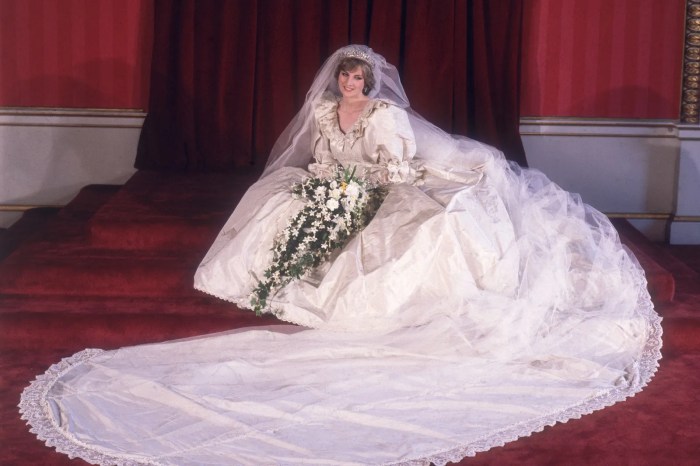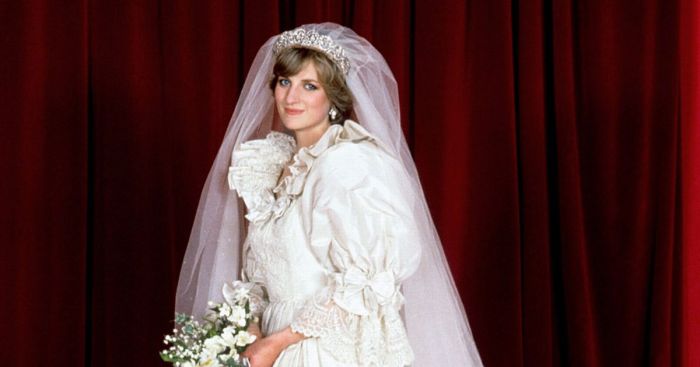Princess Diana Wedding Dress Train Length
Princess Diana’s Wedding Dress Train: A Detailed Examination
Princess diana wedding dress train length – Princess Diana’s wedding dress, with its iconic train, remains a symbol of fairytale romance and enduring style. This analysis delves into the design, construction, impact, and cultural significance of this remarkable garment, exploring its impressive length and the logistical challenges it presented.
The Design and Construction of Diana’s Wedding Dress Train, Princess diana wedding dress train length
The train of Diana’s wedding gown, designed by David and Elizabeth Emanuel, was a masterpiece of craftsmanship. Constructed from antique ivory silk taffeta, it incorporated intricate hand-made lace, delicate embroidery, and layers of tulle to achieve its voluminous and elegant form. The silk taffeta provided a luxurious base, while the lace, possibly featuring motifs of hearts and bows, added a delicate touch of romance.
The tulle layers created the dramatic fullness and cascade effect. The construction likely involved a team of seamstresses working meticulously over several months, piecing together the fabric layers, attaching the lace, and ensuring the train flowed gracefully. Each layer would have been carefully measured and cut, then stitched together with precision, potentially using techniques such as French seams to create a strong and invisible finish.
The final process might have involved pressing and steaming to remove wrinkles and enhance the drape of the train.
The Length and Impact of the Train

Source: tatler.com
Diana’s train measured approximately 25 feet (7.6 meters) in length, significantly longer than many other royal wedding trains. This exceptional length held symbolic weight, representing the grandeur of the occasion and the fairytale nature of the wedding. The train’s dramatic length enhanced the overall aesthetic of the wedding, adding to its visual spectacle and creating a stunning visual impact.
The sheer scale of the train dwarfed other elements, emphasizing its importance.
| Feature | Diana’s Train (approx.) | Other Royal Trains (approx.) | Relative Scale |
|---|---|---|---|
| Length | 25 feet (7.6 meters) | 10-15 feet (3-4.6 meters) | Significantly longer |
| Width | Wide, billowing | Variable | Broader than average |
| Fabric | Silk taffeta, lace, tulle | Silk, satin, lace | Similar materials, luxurious |
| Style | Full, cascading | Variable styles | More dramatic |
The Train’s Role in the Wedding Ceremony and Reception
Managing such an extensive train during the ceremony and reception presented significant logistical challenges. A team of assistants carefully handled and supported the train throughout the proceedings, ensuring it did not become tangled or damaged. The train’s length influenced the choreography of the ceremony and impacted the photography, creating iconic images of the train trailing behind Diana as she walked down the aisle.
The sheer volume of fabric added an element of drama and movement to the event, making for memorable photos and footage.
- Challenge: Preventing the train from becoming tangled or dirty.
- Solution: Employing several assistants to manage and support the train.
- Challenge: Maintaining the train’s shape and drape during the ceremony.
- Solution: Careful placement and support of the train’s layers.
- Challenge: Navigating the train during the procession and reception.
- Solution: Coordinated movement and assistance from the bridal party.
The Cultural and Historical Significance of the Train
Diana’s wedding dress train significantly influenced subsequent bridal fashion, inspiring numerous designers and brides to embrace long, dramatic trains. The train’s romantic and elegant design, coupled with its historical context, cemented its place in bridal fashion history. The key elements contributing to its lasting legacy include its length, the use of high-quality fabrics, and the intricate lace and embroidery. The train’s impact can be seen in the increased popularity of longer trains in contemporary bridal wear.
A timeline illustrating the evolution of royal wedding dress trains could show a gradual increase in train length over time, with Diana’s representing a peak in dramatic scale. Many subsequent royal weddings featured trains of varying lengths, influenced by Diana’s iconic design but also incorporating modern styles and trends.
Illustrative Description of the Train

Source: sandiegotowingca.com
Princess Diana’s wedding dress boasted a famously long train, a breathtaking 25-foot cascade of ivory silk taffeta. In contrast, the figure-hugging silhouette of a pnina tornai mermaid wedding dress offers a completely different aesthetic. While lacking Diana’s dramatic train, the Pnina Tornai style emphasizes a sleek, modern elegance, highlighting a different kind of bridal grandeur. The length of Diana’s train remains a point of enduring fascination, however.
The train possessed a luxurious texture, a substantial weight due to the layers of fabric, and a soft, flowing feel. Viewed from the rear, the train created a breathtaking cascade of fabric, its volume and movement captivating. From the side, the train’s graceful drape and the intricate details of the lace were visible. The train’s interaction with the environment was subtle yet striking, the fabric flowing across the floor, creating ripples and folds as Diana moved.
The visual impact of the train was undeniable: a breathtaking expanse of antique ivory silk taffeta, subtly shimmering with an understated sheen, enhanced by the delicate lace and embroidery. It was a masterpiece of texture and light, a perfect complement to the overall elegance of the gown.
Key Questions Answered: Princess Diana Wedding Dress Train Length
What type of silk was used in Princess Diana’s wedding dress?
The main fabric was ivory silk taffeta.
How many people worked on the dress?
A team of approximately 35 people worked on the dress for months.
How much did the dress cost?
The exact cost is unknown, but estimates range from £9,000 to £15,000 in 1981 values.
Was the train altered after the wedding?
No, the train remained largely unchanged after the wedding.



















